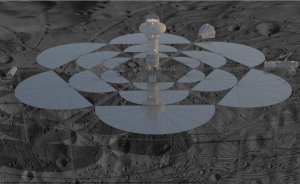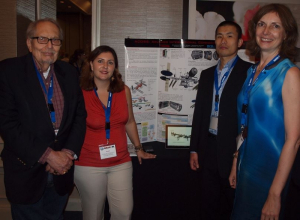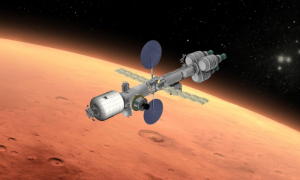Thomas Lagarde has a prediction for us: “In 20 years we are all going to be astronauts.”
“All of us?”
“Yes, you, me, the guy in the office over there, all of us,” he continues.
“But you’re getting your master’s in space architecture, not me!”
“It doesn’t matter,” he persists. “In 20 years the space program will be so privatized that you will buy a ticket for Mars as easily as for Europe.”
Gulp.
Luckily by the time those brave souls buy their tickets, Lagarde and three fellow students may have tackled one of the greatest challenges of interstellar travel— designing a nice, comfortable place for us to stay – a human habitat, complete with solar power, on Phobos, one of the two moons orbiting Mars.
Designing for space
That was the task Lagarde and Victor Kitmanyen, Timothy Bishop and Zachary Taylor, all Master’s students in the space architecture program at the Cullen College of Engineering, tackled and took first place in at the American Institute of Aeronautics and Astronautics (AIAA) design competition.
Their mission on the Phobos Base competition required them to not only create a habitat, replete with the stuff of which human life can thrive on the surface of Phobos, but also to affix it to the moon’s surface in an almost zero-gravity environment.
Their first hurdle was dust and uncertain structure of Phobos grounds.
“Considering the atmosphere, dust on this moon, compared to our moon, is probably easy to pick up and it would just start floating and take a while to come down,” said Kitmanyen. That creates all sorts of problems for scientists who are trying to move around and place things on that surface. “Because of the absence of gravity, it’s hard to get a structure to just stay there,” he said.
Their solution required them to utilize a huge anchoring system made of a series of hooks to anchor the base into the core of the moon.
“This habitat is also unique because we designed it so that 12 crew members, would be able to live and work inside together, and that’s a lot of people compared to the International Space Station (ISS) today, which accommodates six people,” said Kitmanyen.
The director of the space architecture program is especially proud of this team’s winning effort, which for now remains in computer modules and designs.
“These are first semester students in the space architecture program and to jump into the deep end of a very detailed and challenging competition, it is like jumping into cold water,” said Olga Bannova. “If they are capable of doing this in their first semester I think they can work on any team and be successful.”
Bannova knows about success. Another team of her students took second place (behind MIT) in the Revolutionary Aerospace Systems Concepts Academic Linkage (RASC-AL) forum in Cocoa Beach, Fla. in the Commercially Enabled Lower Earth Orbit (LEO)/Mars Habitable Module category.
Those little RASCALs
The team of two consisted of Suzana Bianco and Shunsuke Miyazaki. It should be noted the UH pair was the smallest finalist team and beat other schools which had 40-member teams.
Their challenge was to create a commercial space station with an overall design that could also be applied to a spaceship to Mars, a transfer vehicle, as they are called.
Bianco was very concerned with improving and expanding the design of the current ISS for human comfort.
“The way the ISS is laid out today, there isn’t a very clear separation of functions, everything is kind of mixed, so people sleep next to where someone else works,” said Bianco. “We wanted to make a clear separation where you wouldn’t be walking around your work space unless you were working there.”
So they added modules for sleeping and eating and created what could well become the next station for private use, albeit just yet still in design form.
They also conducted a detailed analysis of elements on the ISS to evaluate how long they will last, what is feasible for reuse, and they reviewed all stages of their station development, along with creating a detailed financial analysis in order to propose a business plan.
Traveling the world to learn about space
Bannova’s students continually compete in competitions that take them around the world. Space, she says, is above politics.
“There is such good cooperation among astronauts and cosmonauts, NASA and other space agencies – it is like a little bubble,” said Bannova. “It is a great atmosphere in which to learn.”
Plus, she says, the world of space learning is much like the world of space travel itself.
“There is so much excitement and energy, it just lifts your spirit and you become inspired by all these people who want to do great things.”


